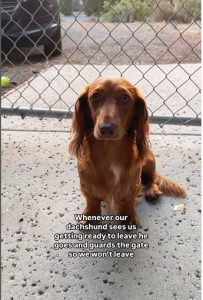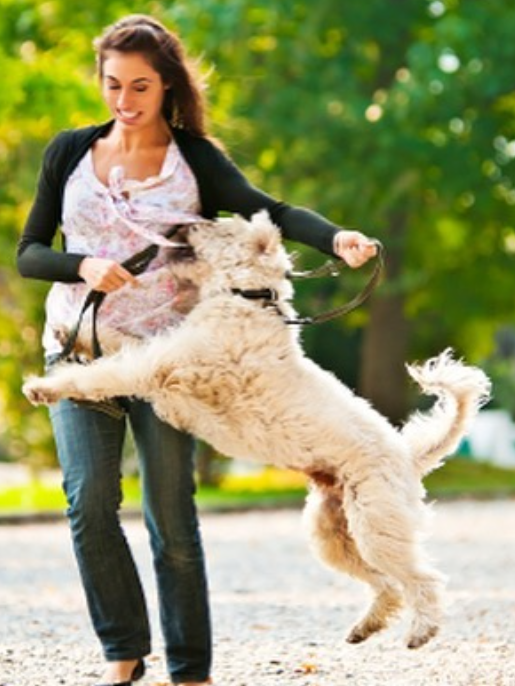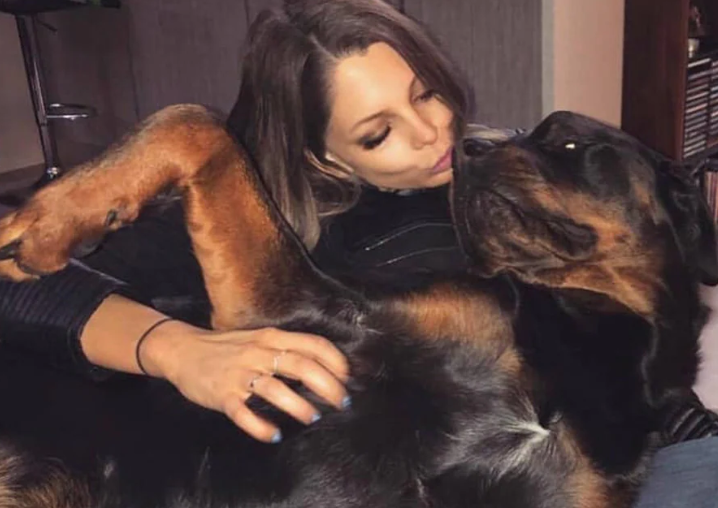
Moment Dachshund Guards Gate to Stop Owner From Leaving
A heartbreaking video of a miniature dachshund, Clovis, guarding his owner’s gate to prevent them from leaving has taken the internet by storm.
The emotional clip captioned “It’s hard to leave him alone” was shared on Instagram on September 26 under the username @clovetheween. The clip showcases the dog’s deep affection and reluctance to be parted from his family.
In the video, the adorable dachshund can be seen sitting sadly by the middle of the gate entrance, seemingly blocking the way. The overlaid text reads, “Whenever our dachshund sees us getting ready to leave, he goes and guards the gate so we won’t leave.”
The video has quickly garnered attention online, with viewers expressing their delight and empathy for the dog’s actions.
“Get him a friend.Omg he looks so cute and sad,” one user said. “It’s so hard to leave him home alone!” another added.
Many shared their own experiences with pets who exhibit similar behaviors when their owners are about to leave.
“I was pulling out of my driveway and I looked in my rear view mirror and saw my dog sitting at the edge of my yard staring at my car so I put my car in park got out ran to her and gave her a very big hug,” shared one user.
“What is so funny is they put on that sad act, but as soon as you leave they go nap like you never existed! We have a Boxer named Jack and he will put ON A SHOW when we leave for work-stand in front of the door-hold his collar in his mouth-the sad eyes. Lordy! It still kills me to leave him though!,” another added.
Since its posting, the video has garnered over 32,000 likes, 140 comments, and over 10,000 shares on Instagram, highlighting the universal love and connection people have with their pets.
The clip serves as a reminder of the deep bond between humans and animals, and the emotional impact that pets can have on our lives. It also sheds light on the common issue of separation anxiety that many dogs experience.
Other than the practical example of Clovis guarding its owner’s gate to prevent them from leaving, this distressing condition manifests in various ways, from excessive barking and whining to destructive behaviors like chewing, digging, or scratching.
Separation anxiety often stems from a strong bond between a dog and its owner. Dogs may develop this condition if they are frequently left alone for extended periods or if they have experienced traumatic events like being abandoned or rehomed. Symptoms can vary from mild to severe, and can significantly impact a dog’s quality of life.
Dogs suffering from separation anxiety may exhibit signs of distress even before their owners leave. They may follow their owners around the house, pace nervously, or become excessively clingy. Once their owners are gone, they may engage in destructive behaviors, howl or whine excessively, or even experience physical symptoms like vomiting or diarrhea.
Addressing separation anxiety requires patience, understanding, and a tailored approach. Consulting with a veterinarian or animal behaviorist is crucial to developing a treatment plan that addresses the underlying causes and provides coping mechanisms for the dog.
One effective strategy is gradual desensitization and counterconditioning. This involves gradually increasing the time a dog spends alone while associating being alone with positive experiences, such as receiving treats or playing with a favorite toy.
Providing mental stimulation and physical exercise can also help alleviate separation anxiety. Interactive toys, puzzle feeders, and regular walks can keep a dog’s mind and body engaged, reducing boredom and anxiety.
Creating a safe and comfortable environment for a dog can also make being alone less stressful. Providing a crate or a designated safe space can give a dog a sense of security and comfort.
Watch the moment Dachshund guards the gate to stop the owner from leaving below:
View this post on Instagram


